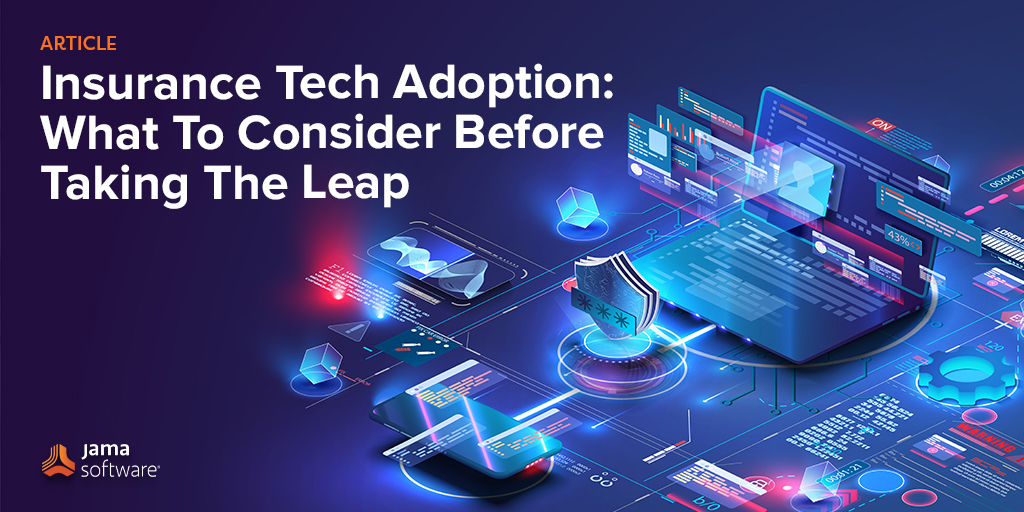Jama Software is always on the lookout for news and content to benefit and inform our industry partners. As such, we’ve curated a series of articles that we found insightful. In this blog post, we share content sourced from Insurance Business America – Insurance Tech Adoptions- What To Consider Before Taking The Leap – which was originally published on March 9, 2022 by Surina Nath.
Insurance Tech Adoption – What To Consider Before Taking The Leap
The industry has been sprinting towards technology adoption over the past few years, but carriers and brokers still need a helping hand when it comes to utilizing newly integrated digital solutions.
There are so many new and shiny platforms coming into the space, and insurtechs are making big promises to insurance companies about how easy the process will be.
“All the noise right now creates a lot of distraction and confusion,” Gilad Komorov, CRO at Lightico told Insurance Business. “Insurance companies have long lists of problems they want to solve, but it’s important to first define a strategy around what to prioritize.”
Breaking down digital goals in a realistic and manageable way enables streamlined processes, and the right tech partners will make sure everything is executed in the right way.
It is too easy for insurance companies to be pulled in a million different directions when it comes to insurtech, but if strategic priorities are established, it helps keep focus on the right aspects.
“A big challenge for insurance companies is doing the homework before evaluating solutions, which is why defining decision criteria is essential,” he said.
Asking how a solution can integrate with an existing technology stack, and how it is compatible with internal processes is vital if an organization is looking for a mature, holistic solution where all boxes will be ticked off.
Related: Accelerate Financial Risk Management and Simplify Complex Insurance Product Development
“Understanding the true business outcome a company is striving for, and assessing what KPIs will be impacted by technological solutions helps drive a much more strategic decision and facilitates a more focused buying process,” said Komorov. “Then comes commercial criteria like budget and ROI.
“If a carrier does their homework, it is easier for the vendor to align with what they’re looking for. I’d advise any carrier to define what they are looking for before looking for solutions. It will help make a more accurate decision.”
To create a comprehensive strategy, a collaborative top-down approach is essential. Middle management needs to ask executives for guidance on what the strategic priorities are for the next two to three years to create a straightforward road map for tech vendors to follow.
“If you don’t think long-term, a company will end up with a stack of solutions that may not work well together to solve the overarching strategic goal,” he said.
Ensuring that a vendor has open APIs that can integrate into back-office systems is another thing carriers and insurers need to consider in the selection process, especially if there is data involved.
“You want that data to be passed from one system to another, and see that APIs not only exist, but are well documented so IT teams can internally know what to do with them,” Komorov explained.
Vendors also need to prove that they have strong technical solutions that will support a company’s infrastructure, as it will help save time getting the new system up and running.
Related: Your Guide to Selecting a Software Requirements Platform for Financial Services and Insurance
“Another thing is the workflow automation, and we put a lot of emphasis on investing time to build a powerful engine that allows different systems to talk to each other. If you can’t build logic across all systems, it will slow down workflow,” he said.
Training and enablement are two key components to consider when implementing new technology, and carriers that partner with vendors that have training programs in place will help drive the adoption process for anyone who needs to engage with the updated platform.
“Evaluating a vendor’s training program is so important,” said Komorov. “A software could be amazing but if it’s not adopted properly, it’s no value for carriers or brokers.”
- 9 Strategies To Overcome Challenges In The EU Medical Device Market In 2025 And Beyond - February 6, 2025
- Leveraging Jama Connect® and Jira for Enhanced Requirements - January 30, 2025
- With Hacks on the Rise, Manufacturers Hone Their Cybersecurity Smarts - January 23, 2025
